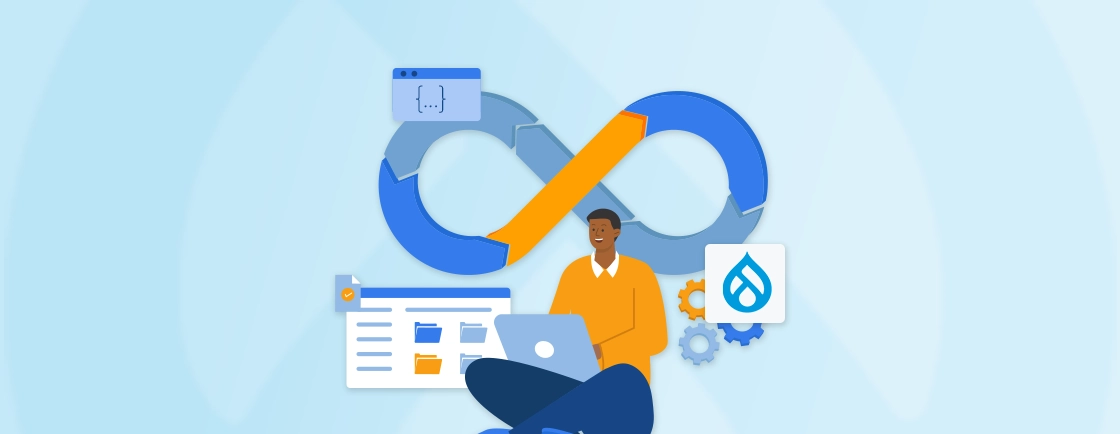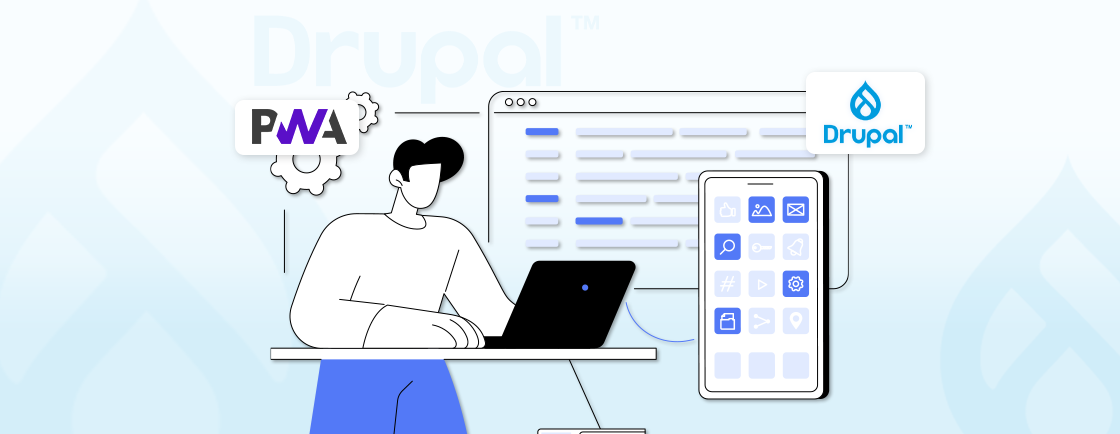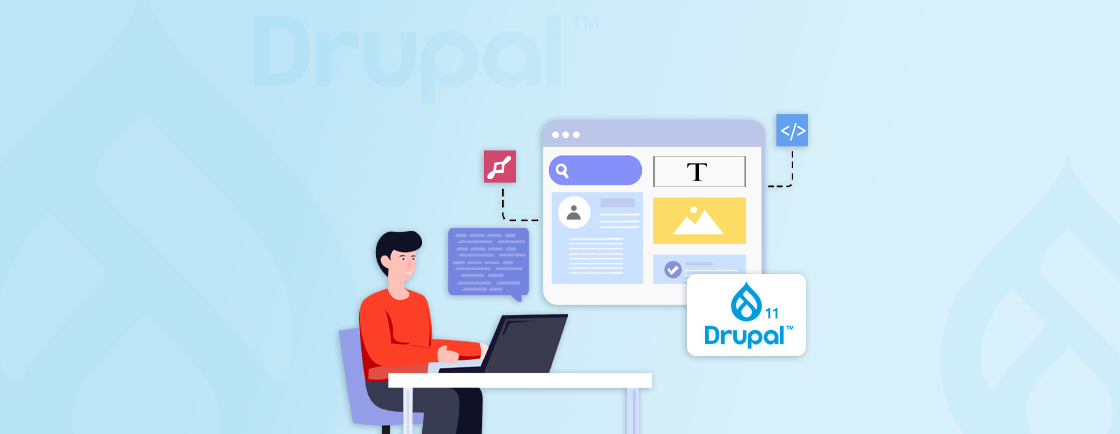Table of Contents
Drupal is one of the best content management systems, powering more than 1.2% of all websites. And this market share is only rising with every new version of Drupal. But still, there are some problems with this CMS, like its complexity and steeper learning curve, to name a few.
Don’t worry though; you can opt for one of the top Drupal alternatives for user-friendliness, scalability, and more. From Webflow and WordPress for content-focused sites to Shopify, Magento, and Wix for eCommerce stores, there are several options available.
So through this blog, we’ll look at a few Drupal alternatives preferred by the best web development experts and provide you with key details on the same.
Potential Reasons to Opt for Alternatives of Drupal
While Drupal remains a powerful CMS for complex websites, it still has some “drawbacks” that lead businesses to explore other options. Here are a few reasons to choose another platform:
Steeper Learning Curve
Drupal is excellent at customization. But that comes at a cost, in that, it can be a little complex and need significant technical expertise. Teams without dedicated developers may struggle with setup, module management, and theme customization.
In that case, simpler alternatives like WordPress and Webflow, with their drag-and-drop interfaces will be better. They have significantly lower onboarding time and let content creators work independently with ease.
High Maintenance
Drupal requires regular security updates, module compatibility checks, and of course, performance tuning. That makes this CMS high-maintenance. Platforms like Shopify and Squarespace handle backend maintenance automatically. That frees the teams to focus on essential operations and business growth rather than upkeep.
Slower Time-to-Market
Drupal’s robust architecture requires extensive configuration, delaying deployment. For fast-paced projects, lightweight options like Wix or Ghost enable rapid prototyping and launch. That is ideal for startups and marketing campaigns where speed is critical.
Costly Scalability
While Drupal scales well, expanding its infrastructure (hosting, caching, CDN) can be expensive. Cloud-based alternatives like Contentful or Strapi offer pay-as-you-grow models. That makes them more budget-friendly for scaling content operations without heavy server investments.
Overkill for Simpler Sites
Not every project needs Drupal’s enterprise-grade features. Small blogs, portfolios, or business websites can function efficiently on platforms like WordPress or even static site generators (e.g., Jekyll). That reduces unnecessary complexity and costs.
So if you are stuck with any of these issues with your setup, it might be time to look for the most viable Drupal alternatives.
You may not even need to look for an alternative. If you prefer Drupal for your website but encounter any sorts of problems, consult with our dedicated Drupal development company.
Top Drupal Alternatives
But since there are many good ones, it might be a little tricky to choose the best one. That’s why we have narrowed down the choices to top 10 and aid your decision.
WordPress
Powering over 43% of all websites, WordPress is the world’s most popular CMS—ideal for blogs, business sites, and even complex portals. Its vast plugin ecosystem (59,000+ free plugins) and intuitive editor make it highly flexible, though security and performance require active management.
Best for agencies and creatives, Webflow speeds up prototyping and publishing—though advanced features require a learning curve, and large-scale sites may face cost limitations.
Pros
- User-friendly with a simple interface for beginners.
- Massive plugin/themes ecosystem (60,000+ plugins).
- Strong SEO capabilities with tools like Yoast SEO.
- Highly customizable for blogs, business sites, and eCommerce (via WooCommerce).
- Large community for support and troubleshooting.
Cons
- Security vulnerabilities (requires regular updates & plugins monitoring).
- Performance issues if overloaded with plugins.
- Limited scalability for complex enterprise needs without heavy optimization.
Best for: Blogs, small-to-medium businesses, content-heavy sites.
Pricing: Free platform
Webflow
Webflow combines visual design and CMS capabilities into a no-code solution perfect for designers and marketers. Unlike Drupal, it hides backend complexity from you, while allowing dynamic content, responsive layouts, and hosting.
Best for agencies and creatives, Webflow speeds up prototyping and publishing. But some of its advanced features require a learning curve. Plus, large-scale sites may face cost limitations.
Pros
- No-code visual builder with design flexibility.
- Built-in CMS & hosting for seamless publishing.
- Responsive design out of the box.
- Good for prototyping and designer-friendly workflows.
Cons
- Steep learning curve for non-designers.
- Limited backend functionality compared to open-source CMS.
- Higher cost for advanced features.
Best for: Designers, agencies, marketing sites, and portfolios.
Pricing: Free plan available. Paid plans start from $14 per month.
Magento (now Adobe Commerce)
Magento is a great eCommerce solution with enterprise-level features suitable for large-scale online stores. While Drupal can handle commerce via modules, Magento offers built-in product management, multi-store support, and robust extensions.
However, its steep learning curve and high hosting demands make it overkill for small businesses. Shopify or WooCommerce (WordPress) may be better for simpler setups.
Pros
- Powerful eCommerce features (multi-store, B2B support).
- Highly scalable for large enterprises.
- Extensive customization via extensions.
Cons
- Expensive (hosting, development, licensing for Adobe Commerce).
- Requires technical expertise to manage.
- Slow performance if not optimized properly.
Best for: Large online stores with complex product catalogs.
Pricing: Get customized pricing.
Shopify
Shopify is that one solution for anyone trying to start an eCommerce business with no hassle. It contains everything: hosting, security, and payment processing-the ultimate all-in-one solution. In contrast to Drupal’s manual setup, Shopify allows store launches in a matter of hours using drag-and-drop tools.
Comparatively, its customization may be limited versus open-source platforms. However, it offers scalability, app ecosystem, and 24/7 support. That positions it as a prominent contender for an enterprise that favors convenience over technical control.
Pros
- Easy setup; launch stores in hours.
- All-in-one solution (hosting, security, payments).
- App store for extending functionality.
- Reliable scalability for growing businesses.
Cons
- Monthly costs add up (apps, transaction fees).
- Less customization freedom than open-source platforms.
- Limited SEO control compared to WordPress/Magento.
Best for: Small-to-medium eCommerce businesses, dropshipping.
Pricing: Starts from $29 per month.
Joomla
Joomla strikes a balance between the complexity of Drupal and simplicity of WordPress. It provides strong multilingual support and user management out of the box. It’s suitable for those mid-sized enterprises that generally need structured content but do not have to customize it too extensively.
However, the developer community is smaller, which translates with fewer extensions compared to WordPress. Also, performance tuning is harder when compared with the latest SaaS alternatives like Squarespace.
Pros
- Balanced flexibility–more powerful than WordPress but less complex than Drupal.
- Strong multilingual support (built-in).
- Good for structured content (e.g., membership sites).
Cons
- Smaller community than WordPress.
- Fewer themes/extensions available.
- Performance tuning needed for high traffic.
Best for: Community portals, medium-sized business sites.
Pricing: Free platform
Squarespace
For small, visually-driven businesses and portfolios, Squarespace is the best fit because it comes with beautiful templates and editing very easy. Unlike Drupal, it does not even require any maintenance or coding. That is because hosting, security, and updates are done automatically.
While less flexible for complex workflows, Squarespace does offer built-in SEO tools, analytics, and eCommerce features. That makes it a low-friction choice for creatives and solopreneurs.
Pros
- Stunning templates for visually appealing sites.
- All-in-one hosting & maintenance.
- Easy drag-and-drop editor.
- Good for small businesses & portfolios.
Cons
- Limited customization (no plugins like WordPress).
- Not ideal for large-scale sites.
- Higher pricing for eCommerce features.
Best for: Artists, small businesses, portfolios.
Pricing: Starts from $16 per month.
Contentful
Contentful is a headless CMS, in that you separate the content from the presentation. It’s excellent for omnichannel digital experiences. Unlike Drupal’s monolithic setup, Contentful offers APIs for seamless integration with apps, IoT devices, etc.
All developers appreciate its scalability, but users new to technology may find the absence of a frontend a limitation. So it’s best suited for teams with strong tech resources and multi-platform content needs.
Pros
- Headless CMS, great for omnichannel content.
- API-first approach (integrates with any frontend).
- Scalable for enterprises.
Cons
- No built-in frontend (requires developer setup).
- Expensive at scale.
- Steep learning curve for non-tech users.
Best for: Developers, enterprises with multi-platform content needs.
Pricing: Starts from $300 per month.
Wix
Wix attracts the novices through its drag-and-drop editor as well as the intelligent AI-powered design tools. Wix attracts the novices through its drag-and-drop editor as well as the intelligent design tools powered by artificial intelligence. Its trade-offs include less control over SEO and performance compared to open source CMSs.
But for small companies or personal sites that require simplicity, Wix gives good value.
Pros
- Easiest to use (drag-and-drop, AI tools).
- Affordable for beginners.
- All-in-one hosting & maintenance.
Cons
- Limited SEO capabilities.
- No migration flexibility (hard to switch platforms).
- Slower performance compared to optimized CMS.
Best for: Small businesses, personal websites, quick launches.
Pricing: Starts from $17 per month.
TYPO3
TYPO3 is a powerful open-source CMS. It’s preferred by large and medium enterprises, reason being its scalability and granular permissions. Like Drupal, it handles complex content structures well. However, it comes steep in terms of learning curve.
It shines mainly in multi-site governance and compliance capabilities. That makes it a niche product for corporations and government entities. It’s because they require strict governance over digital assets.
Pros
- Enterprise-grade scalability.
- Strong multi-site management.
- High security & compliance features.
Cons
- Very steep learning curve.
- Requires developer expertise.
- Smaller community than WordPress/Drupal.
Best for: Large corporations, universities, government sites.
Pricing: Free platform.
HubSpot CMS
HubSpot CMS delivers content management with the help of CRM within the marketing process, perfect for inbound strategies. Unlike Drupal, HubSpot natively delivers integration with HubSpot’s sales and automation platforms. So you can create personalized user journeys.
However, HubSpot is less customizable than open-source options. Still, its all-in-one approach simplifies analytics, SEO, and lead generation for marketing teams. That makes it ideal for growth-focused businesses.
Pros
- Built-in CRM & marketing tools.
- Good for inbound marketing & lead gen.
- Secure & managed hosting.
Cons
- Expensive (higher-tier plans needed for full features).
- Less flexible than open-source CMS.
- Limited third-party integrations.
Best for: Marketing teams, businesses using HubSpot’s ecosystem.
Pricing: Starts from $450 per month.
When you approach a professional web development company, they evaluate your requirements and choose one of these or another platform for the project. But what kind of factors do they consider for selection? Let’s find out.
How to Pick the Best Drupal Alternative?
There is no one-size-fits-all decision when it comes to choosing the best alternative to Drupal for your project. There are certain factors which vary according to your business (or project) needs. Let’s discuss them one at a time.
Project Complexity
Not all sites really need the advanced features of Drupal. For instance, simple blogs or portfolios could go with WordPress or Wix. And very complex systems for an enterprise might be better off with TYPO3 or Contentful. Match the capabilities of the platform with the needs of your project to avoid having unwarranted overhead or limitations.
Technical Expertise
Using Drupal needs developer expertise, as opposed to alternative platforms like Squarespace or Shopify. They offer no-code, DIY solutions. If such a condition is met, go for the easiest drag-and-drop editors along with managed hosting.
Scalability Requirements
High-growth businesses need platforms that scale effortlessly. WordPress (with optimizations) and Contentful handle traffic well, while Shopify and Magento suit scaling eCommerce. Avoid rigid systems like Wix for large-scale expansions.
Project Budget
Costs vary widely—open-source options (WordPress, Joomla) save on licensing. SaaS platforms (Shopify, HubSpot), however, add recurring fees. Factor in hosting, plugins, and developer costs to avoid surprises.
eCommerce Requirements
Not all CMS platforms support online stores. Shopify excels in ease, Magento in power, and WooCommerce (WordPress) balances both. Pick based on product volume, payment gateways, and customization needs.
Content Management
Structured content needs (e.g., multilingual sites) favor Joomla or TYPO3, while visual-heavy sites thrive on Webflow. Headless CMSs like Contentful work best for omnichannel content delivery.
Maintenance & Hosting
Self-hosted platforms (Drupal, WordPress) demand updates and security patches. Managed solutions (Squarespace, Shopify) handle this for you—ideal for teams lacking IT support.
Security & Compliance
Industries like finance or healthcare need robust security. TYPO3 and HubSpot CMS offer strong compliance features, while open-source platforms require manual hardening. Always prioritize data protection.
Assess your team’s technical skills, long-term goals, and required features to make the best choice. You may also consult with the experts to get a better idea on the suitable Drupal alternative.
Let’s Summarize
While Drupal is an excellent platform for building high-quality websites, there are some reasons to look the other way. It’s relatively complex, has a steeper learning curve, and requires higher maintenance. Drupal is rather an overkill for most projects.
That’s why platforms like WordPress, Webflow, Shopify, Magento, Wix, Joomla, Squarespace, etc. are considered viable Drupal alternatives. The particular choice depends on project complexity, technical expertise, scalability, budget, security, hosting, and more. For more info on selecting the right Drupal alternative and creating the best website, connect with our web professionals today!
FAQs on Drupal Alternatives
Why should I consider a Drupal alternative?
While Drupal is powerful, its complexity, high maintenance, and steep learning curve make it overkill for many projects. Alternatives like WordPress, Webflow, or Shopify offer easier setups, lower costs, and faster deployment for most business needs.
Which Drupal alternative is best for beginners?
For non-technical users, Wix and Squarespace are the easiest, offering drag-and-drop builders. WordPress is also beginner-friendly but requires some learning for advanced customization.
Is there a good headless CMS alternative to Drupal?
Yes, Contentful and Strapi are excellent headless options. They offer API-driven content management for developers building multi-channel experiences.
Is there a Drupal alternative with built-in marketing tools?
HubSpot CMS integrates directly with CRM and marketing automation. There’s also Shopify and Squarespace, which offer built-in SEO and analytics tools.
Which Drupal alternative offers the best balance of power and ease of use?
Webflow strikes an excellent balance, offering visual design control with CMS capabilities, while WordPress remains the most versatile for users who want both simplicity and extensibility through plugins.
Are there other good alternatives for headless architecture?
Some of the top choices for good headless architecture include Contentful, Strapi, Prismic, and of course, WordPress. You need to check if the platform will work well as the backend for the website while choosing a more suitable frontend.
Unleash the Potential of Drupal
Access expert guides and insights to leverage Drupal for scalable and secure web solutions.





